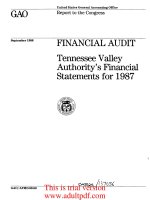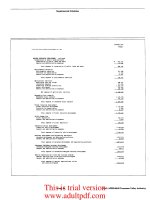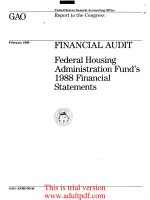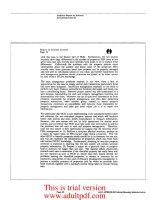United States General Accounting Office GAO July 1996 Report to the Congress FINANCIAL AUDIT_part2 doc
Bạn đang xem bản rút gọn của tài liệu. Xem và tải ngay bản đầy đủ của tài liệu tại đây (193.25 KB, 11 trang )
B-261816
This occurs because the system requires that corporate and individual
taxpayers pay multiple taxes at the same time without readily identifying
the application of the payments to the various taxes paid.3 As a result, IRS
is forced to make the allocation of collections to the recipient based on the
total tax owed as identified on the related tax return. The tax return is
filed at a later date and may not contain sufficient information if the
amount of taxes owed on the return does not agree with the amount paid,
as is sometimes the case.
has developed computer programs to extract the detailed masterfile
data from its records but continues to be unable to reconcile the detailed
extracted data to the summary accounts. In an interim effort to prepare
reliable financial statement information, IRS is attempting to demonstrate
the maximum exposure likely attributable to the unexplained differences
and provide the necessary information to fix the identified system flaws.
This interim plan involves IRS continuing its efforts to develop detailed
comprehensive documentation of its current financial management
system. We are monitoring IRS’ efforts closely, providing guidance and
recommendations, and reporting at regular intervals to IRS’ senior
management on the agency’s progress and actions needed to correct these
problems in the short and long term.
IRS
As reported since our audit of IRS’ fiscal year 1992 financial statements, IRS
cannot ensure that it distributes excise taxes based on collections, as
required by law, because it bases these distributions on the amount
reported on the tax return, that is, the assessed amount. However, during
fiscal year 1995, IRS analyzed excise taxes by specific trust funds to
determine if there were significant differences between taxes paid and
amounts reported as owed on the return and found that these differences
were insignificant. Because IRS completed this analysis after our audit was
completed, we were unable to examine and determine the reliability of
this information.
Accounts Receivable
For fiscal year 1995, IRS attempted to test a statistical sample of its
inventory of open assessments to categorize them between financial
accounts receivable and compliance assessments.4 For all the 4 fiscal
3
For an explanation of how IRS processes tax returns, tax information, and payments, see Financial
Audit: Actions Needed to Improve IRS Financial Management (GAO/T-AIMD 96-96, June 6, 1996).
4
Compliance assessments occur when IRS records an assessment to a taxpayer’s account, but neither
the taxpayer nor a court has agreed that the assessment is appropriate. IRS makes these assessments
to encourage compliance with the tax laws. Financial accounts receivable arise when taxpayers agree
to assessments or a court determines that an amount is owed.
This is trial version
www.adultpdf.com
Page 10
GAO/AIMD-96-101 IRS Financial Audit
B-261816
years we have audited5 IRS’ financial statements, IRS has had difficulty
separating, in its masterfile records of taxpayer accounts, its financial
accounts receivable, from the amounts it has assessed only for compliance
purposes because the design of IRS’ masterfiles commingles these
amounts.
In fiscal year 1995, IRS expanded its previous years’ efforts by trying to first
separate the inventory of assessments into accounts receivable and
compliance assessments based on its coding of these assessments in its
financial management system and then testing the accuracy of this coding
to separate accounts receivable from compliance assessments on a
taxpayer account basis. However, these efforts were unsuccessful because
of mistakes made in performing the statistical tests and errors found in the
coding of the assessments in IRS’ financial management systems which
made the sample results unreliable for projecting to the total inventory of
outstanding assessments. Our tests of the fiscal year 1995 data found
significant errors at levels that made the result of any projections from the
samples taken unreliable.
The actions needed to resolve the key financial management control
weaknesses in accounts receivable are consistent with recommendations
from our prior reports and are as follows: (1) better review and approval
procedures are needed before assessment information is entered into IRS’
masterfile system, (2) clearer lines of authority and responsibility are
needed between IRS’ taxpayer service and the Chief Financial Officer’s
operations to ensure that internal control procedures are properly
identified and strictly adhered to, (3) procedures need to be developed for
processing in-process accounts and properly applying them to the
respective taxpayer accounts, and (4) periodic detailed taxpayer account
reviews should be performed as a quality review measure to ensure that
the proper coding is taking place for taxpayer accounts. In addition, IRS
needs to (1) continue its efforts to review taxpayer accounts with amounts
owed to ensure that they are properly coded and accounted for and
(2) perform more macro analysis of its inventory of assessments to
identify aberrations and other systemic problems that will need to be
corrected to accurately report on accounts receivable. We will continue to
monitor IRS’ progress in this area and provide guidance and
recommendations as it proceeds.
5
For a discussion of the problems with IRS’ accounts receivable in our fiscal years 1992 through 1994
audits, see Financial Audit: Actions Needed to Improve IRS Financial Management
(GAO/T-AIMD-96-96, June 6, 1996).
This is trial version
www.adultpdf.com
Page 11
GAO/AIMD-96-101 IRS Financial Audit
B-261816
Administrative Operations
Have Improved but More
Improvement Is Needed
For fiscal year 1995, IRS had a reported $8.1 billion in operating expenses
and related assets and liabilities used and incurred in its administrative
operations. The key asset in its administrative operations is its Fund
Balance with Treasury accounts and the related Unexpended
Appropriations accounts. Its operating expenses can be readily separated
between its efforts to account for and report, in fiscal year 1995, its
$5.3 billion in payroll costs and $2.8 billion in nonpayroll costs.
has made progress in accounting for and reporting its administrative
operations. In fiscal year 1992, for the most part, we were unsuccessful in
our attempts to audit IRS’ records for its administrative operations. IRS’
accounting records were in total disarray, and it could not substantiate
large portions of the reported amounts. In addition, internal control
policies and procedures were either nonexistent, inappropriately focused,
or not followed. For fiscal year 1995, IRS had a core accounting system in
place that tracked its financial management activity. Two critical
problems, however, have continued to persist that were identified in our
fiscal year 1992 audit: (1) IRS’ Fund Balance with Treasury accounts remain
unreconciled, though some progress has been made toward that end and
(2) IRS has not been able to provide support as to whether and when
certain nonpayroll goods and services paid for were received and, in
instances where support existed, we found that the cost associated with
the purchase was often recorded and reported in the wrong fiscal year.
IRS
Fund Balance With Treasury
IRS’
Fund Balance with Treasury accounts historically were not being
reconciled. For the most part, IRS’ personnel were only tracking the gross
differences between their accounting records and what Treasury (the
equivalent of their bank) reported to them for their administrative receipts
and disbursements. This resulted in years of unreconciled amounts
accumulating that were never researched and resolved and that were
made difficult to research and resolve when the amounts were required to
be audited.
These accounts have been unreconciled in each of the years of our prior
audits—1992 through 1994—with net reconciling differences in the
millions of dollars that were made up of gross reconciling differences in
the hundreds of millions of dollars. We were not provided the information
to fully determine the gross amount of the differences for fiscal year 1995
and, thus, while we do know the accounts remain unreconciled, we do not
know by how much.
This is trial version
www.adultpdf.com
Page 12
GAO/AIMD-96-101 IRS Financial Audit
B-261816
Over the last 2 fiscal years, IRS has made adjustments to its accounting
records to write off large portions of the gross unreconciled amounts
where it could not determine what the correct disposition of the difference
should be after several efforts at researching the items. In addition, it hired
a contractor to identify the differences6 between its accounting records
and what it had reported to Treasury as its activity in its Fund Balance
with Treasury accounts. IRS, though, has still not fully reconciled its
differences between its records and Treasury’s records that are reported
to IRS through its budget clearing accounts7—for items that are more than
6 months old that remain unreconciled—and that are identified on its
statement of differences—for similar items that are less than 6 months old.
Similarly, IRS still needs to investigate and resolve amounts in its suspense
accounts, many of which have been in suspense for 1 year or more. In
addition, IRS has not disposed of some of the reconciling items between its
accounting records and what it reported to Treasury that were identified
by the contractor. Through further contractor assistance or more
intensified internal efforts, IRS must get these accounts fully reconciled. In
addition, IRS needs to look more closely at the skill mix of its staff assigned
with the responsibility of completing this reconciliation process.
If these accounts remain unreconciled, it will continue to be difficult to
provide an opinion on either IRS’ administrative financial statements or
management’s assertion about the effectiveness of internal controls. It will
also continue to be impossible to determine whether IRS has complied with
all of the appropriate laws and regulations to which it is subject.
Notwithstanding the problems these unreconciled accounts present for
rendering an opinion, these accounts make it impossible, or at best
difficult, for IRS or anyone else to know whether its operating funds have
been improperly spent and calls into question the accuracy of its reported
operating expenses, assets, and liabilities.
Receipt and Acceptance
did not provide support as to whether and when it received goods and
services for significant portions of its nonpayroll operating expenses and,
in several instances where the support was provided, we found that the
cost should have been included in another period. Simply stated, this
situation is much like when IRS audits a taxpayer. If the taxpayer cannot
IRS
6
Much like what occurs with a checking account, differences between accounting records and bank
records can occur because of timing differences or errors in recording transactions. However, the
differences identified by the contractor were those between IRS’ accounting records and the reports of
receipts and disbursements IRS sends to Treasury.
7
Budget clearing accounts are accounts that serve as suspense accounts for unidentified transactions.
This is trial version
www.adultpdf.com
Page 13
GAO/AIMD-96-101 IRS Financial Audit
B-261816
show independent evidence that an expense that was deducted on the tax
return was incurred in the year under audit, the expense would be
disallowed and the taxpayer’s tax liability increased. Likewise, when IRS
cannot provide support for its reported expenses or the support shows
that the expenses should be properly included in a different fiscal year, the
auditor cannot provide an opinion on the amounts. Simply put, we cannot
determine whether this expense was an expense of the current
period—when no support exists—or whether it must be adjusted from the
current year’s expenses—when the support shows it is in the wrong
period. Our interim testing of IRS’ accounting records covering the first 10
months of fiscal year 1995 showed significant amounts of nonpayroll costs
that were either unsupported or recorded in the wrong period.
IRS’
nonpayroll expenses that we reviewed included purchases from other
federal agencies as well as from commercial vendors for printing services,
postage, computer equipment, and many other costs. IRS’ lack of control
over receipt and acceptance of goods and services, combined with its
problems in linking the controls over goods and services purchased to the
payment for these goods and services, makes it especially vulnerable to
vendors, both federal and commercial, billing IRS for goods and services
not provided or for amounts in excess of what was provided. This would
be comparable to an individual or business receiving an invoice and paying
it without verifying that the purchased item had been received and
accepted, based on an assumption that someone else in the household or
business received it. For example, IRS has an inventory management
system that tracks when printed tax forms are received and used.
However, the information tracked in this system is not used or integrated
with the payment system for making vendor payments nor with any other
system used to account for and report IRS’ operating expense for printing
these forms.
Computer Security
In our prior year reports,8 we stated that IRS’ computer security
environment was inadequate. Our review of controls over IRS’
computerized information systems, done to support our fiscal year 1995
audit, found that IRS has made some progress in addressing and initiating
actions to resolve prior years’ computer security issues; however, some of
the fundamental security weaknesses we previously identified continued
8
Financial Audit: Examination of IRS’ Fiscal Year 1992 Financial Statements (GAO/AIMD-93-2, June 30,
1993); IRS Information Systems: Weaknesses Increase Risk of Fraud and Impair Reliability of
Management Information (GAO/AIMD-93-34, September 22, 1993); Financial Audit: Examination of
IRS’ Fiscal Year 1993 Financial Statements (GAO/AIMD-94-120, June 15, 1994); and Financial Audit:
Examination of IRS’ Fiscal Year 1994 Financial Statements (GAO/AIMD-95-141, August 4, 1995).
This is trial version
www.adultpdf.com
Page 14
GAO/AIMD-96-101 IRS Financial Audit
B-261816
to exist in this fiscal year. We will be studying these issues further and
reporting on them in greater detail in a future report.
These deficiencies in internal controls may adversely affect any decision
by management which is based, in whole or in part, on information that is
inaccurate because of the deficiencies. Unaudited financial information
reported by the Internal Revenue Service, including budget information,
also may contain misstatements resulting from these deficiencies.
Disclaimer of Opinion
on Principal
Statements
As described above, we are unable to give an opinion on the Principal
Financial Statements for fiscal year 1995. In addition, we were unable to
give an opinion on the Principal Financial Statements for fiscal year 1994.9
Statement on Internal
Controls
We gained an understanding of internal controls designed to
•
•
•
safeguard assets against loss from unauthorized acquisition, use, or
disposition;
assure the execution of transactions in accordance with laws governing
the use of budget authority and with other laws and regulations that have a
direct and material effect on the Principal Financial Statements or that are
listed in Office of Management and Budget (OMB) audit guidance and could
have a material effect on the Principal Financial Statements; and
properly record, process, and summarize transactions to permit the
preparation of reliable financial statements and to maintain accountability
for assets.
For fiscal years 1995 and 1994, we do not express an opinion on internal
controls because the scope of our work was limited to determining our
procedures for auditing the financial statements, not to express an opinion
on internal controls. However, we found that the material weaknesses,
described in the Significant Matters section of this report, resulted in
ineffective controls that could lead to losses, noncompliance, or
misstatements that are material in relation to the financial statements. Our
9
See our fiscal year 1994 audit report Financial Audit: Examination of IRS’ Fiscal Year 1994 Financial
Statements (GAO/AIMD-95-141, August 4, 1995). See appendixes I and III of that report for a detailed
explanation of our findings and recommendations, along with the status of IRS’ corrective actions to
respond to the problems we identified in our financial statement audits for fiscal years 1992, 1993, and
1994. At the completion of our audit for fiscal year 1994—which was substantively completed on
May 1, 1995—IRS had completed 13 of the 59 recommendations that had been made.
This is trial version
www.adultpdf.com
Page 15
GAO/AIMD-96-101 IRS Financial Audit
B-261816
internal control work would not necessarily disclose all material
weaknesses.
Compliance With
Laws and Regulations
Because of the limitations on the scope of our work as discussed above,
we were unable to test the laws we considered necessary;10 accordingly,
we are unable to report on IRS’ compliance with laws and regulations.
Status of
Recommendations
and Future Steps
Needed
In our prior year reports (see footnote 1), we made 59 recommendations
aimed at resolving IRS’ financial management problems. In our assessment
this year, we determined that IRS had completed 17 of these
recommendations. See appendix I for the status of IRS’ implementation
efforts on the 59 recommendations from our prior year reports. IRS has
stated its intention to commit the necessary resources and management
oversight to resolve its financial management weaknesses and receive its
first opinion on the fiscal year 1996 financial statements. In this regard, we
are providing advice to IRS on how to resolve its long-standing and
pervasive financial management problems.
Objectives, Scope,
and Methodology
Management is responsible for
•
•
•
preparing the annual financial statements in conformity with the basis of
accounting described in note 1 of the Administrative and Custodial
financial statements;
establishing, maintaining, and assessing the internal control structure to
provide reasonable assurance that the broad control objectives of the
Federal Managers’ Financial Integrity Act (FMFIA) are met; and
complying with applicable laws and regulations.
We attempted to perform audit procedures on the limited information IRS
was able to provide; however, for the reasons stated above, we were
unable to perform the necessary audit procedures to opine on IRS’
Principal Financial Statements.
Except for the limitations on the scope of our work on (1) the Principal
Financial Statements, (2) internal controls, and (3) compliance with laws
and regulations described above, we did our work in accordance with
10
These are laws governing the use of budget authority and other laws and regulations that have a
direct and material effect on the Principal Financial Statements or that are listed in OMB audit
guidance and could have a material effect on the Principal Financial Statements.
This is trial version
www.adultpdf.com
Page 16
GAO/AIMD-96-101 IRS Financial Audit
B-261816
generally accepted government auditing standards and OMB Bulletin 93-06,
“Audit Requirements for Federal Financial Statements.”
We requested written comments on a draft of this report from you or your
designee. Your office provided us with written comments which are
discussed in the following section and reprinted in appendix II.
Agency Comments
and Our Evaluation
In commenting (see appendix II) on a draft of this report, IRS generally
agreed with the facts as stated in our report. In addition, IRS reaffirmed its
commitment to ensuring the integrity of its financial data.
Charles A. Bowsher
Comptroller General
of the United States
May 17, 1996
This is trial version
www.adultpdf.com
Page 17
GAO/AIMD-96-101 IRS Financial Audit
Principal Financial Statements
This is trial version
www.adultpdf.com
Page 18
GAO/AIMD-96-101 IRS Financial Audit
Principal Financial Statements
Overview to the Financial Statements
This is trial version
www.adultpdf.com
Page 19
GAO/AIMD-96-101 IRS Financial Audit
Principal Financial Statements
This is trial version
www.adultpdf.com
Page 20
GAO/AIMD-96-101 IRS Financial Audit









